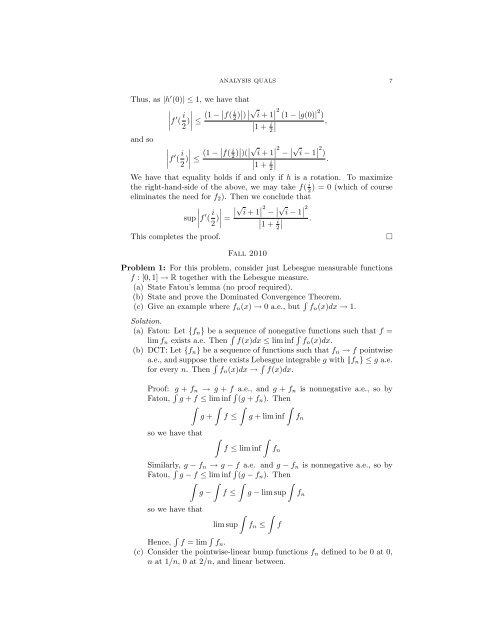ANALYSIS QUALIFYING EXAM PROBLEMS BRIAN LEARY ...
ANALYSIS QUALIFYING EXAM PROBLEMS BRIAN LEARY ...
ANALYSIS QUALIFYING EXAM PROBLEMS BRIAN LEARY ...
You also want an ePaper? Increase the reach of your titles
YUMPU automatically turns print PDFs into web optimized ePapers that Google loves.
<strong>ANALYSIS</strong> QUALS 7<br />
Thus, as |h ′ (0)| ≤ 1, we have that<br />
<br />
<br />
<br />
f ′ ( i<br />
2 )<br />
<br />
<br />
<br />
≤ (1 − i f( 2 ) √ 2 ) i + 1 2<br />
(1 − |g(0)| )<br />
<br />
1 + i<br />
<br />
<br />
,<br />
and so<br />
<br />
<br />
<br />
f ′ ( i<br />
2 )<br />
<br />
<br />
<br />
≤ (1 − i f( 2 ) √ 2 √ 2 )( i + 1 − i − 1 )<br />
<br />
i 1 + <br />
.<br />
We have that equality holds if and only if h is a rotation. To maximize<br />
the right-hand-side of the above, we may take f( i<br />
2 ) = 0 (which of course<br />
eliminates the need for f2). Then we conclude that<br />
<br />
<br />
sup <br />
f ′ ( i<br />
2 )<br />
<br />
<br />
<br />
=<br />
<br />
√ i + 1 2 − √ i − 1 2<br />
<br />
1 + i<br />
<br />
<br />
.<br />
This completes the proof. <br />
Fall 2010<br />
Problem 1: For this problem, consider just Lebesgue measurable functions<br />
f : [0, 1] → R together with the Lebesgue measure.<br />
(a) State Fatou’s lemma (no proof required).<br />
(b) State and prove the Dominated Convergence Theorem.<br />
(c) Give an example where fn(x) → 0 a.e., but fn(x)dx → 1.<br />
Solution.<br />
(a) Fatou: Let {fn} be a sequence of nonegative functions such that f =<br />
lim fn exists a.e. Then f(x)dx ≤ lim inf fn(x)dx.<br />
(b) DCT: Let {fn} be a sequence of functions such that fn → f pointwise<br />
a.e., and suppose there exists Lebesgue integrable g with fn} ≤ g a.e.<br />
for every n. Then fn(x)dx → f(x)dx.<br />
2<br />
2<br />
Proof: g + fn → g + f a.e., and g + fn is nonnegative a.e., so by<br />
Fatou, g + f ≤ lim inf (g + fn). Then<br />
<br />
<br />
g + f ≤ g + lim inf<br />
so we have that<br />
<br />
<br />
f ≤ lim inf<br />
Similarly, g − fn → g − f a.e. and g − fn is nonnegative a.e., so by<br />
Fatou, g − f ≤ lim inf (g − fn). Then<br />
<br />
<br />
g − f ≤ g − lim sup<br />
so we have that<br />
<br />
lim sup<br />
fn ≤<br />
Hence, f = lim fn.<br />
(c) Consider the pointwise-linear bump functions fn defined to be 0 at 0,<br />
n at 1/n, 0 at 2/n, and linear between.<br />
<br />
2<br />
fn<br />
f<br />
fn<br />
fn
















